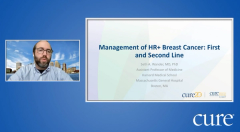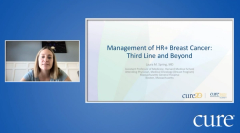
Educated Patient® Metastatic Breast Cancer Summit HR-Positive Disease Panel: November 12, 2022
Watch Dr. Aditya Bardia, Dr. Seth A. Wander and Dr. Laura M. Spring answer questions about HR-positive disease during the CURE Educated Patient Metastatic Breast Cancer Summit.
Episodes in this series

This panel was moderated by summit co-chair Dr. Aditya Bardia, director of breast cancer research at Mass General Cancer Center, and included Dr. Seth A. Wander, instructor in medicine at Harvard Medical School and Massachusetts General Hospital; and Dr. Laura M. Spring, attending physician in breast medical oncology at Massachusetts General Hospital and Harvard Medical School.
Bardia: Let me start with the first one to Dr. Wander. And this relates to something he had mentioned related to CDK4/6 inhibitors and the differences between the three CDK4/6 inhibitors. So two-part question, first is do you think that all three CDK4/6 inhibitors are the same? And second, how do you explain the difference in overall survival between the drugs? And should there be a preferred one for patients?
Wander: Thanks for this important question. I don't think they're all the same. I think there are a number of important pharmacokinetic and pharmacodynamic, meaning how the drug is metabolized and how the drug interacts with its targets, differences between these agents. We know this also based on the side effect profile, and based on the dosing schedule. These drugs are delivered differently, they have different side effects. And there's a lot of work going on, both with our team and with other teams around the country to start to dissect these differences in a more precise way.
I think the second part of the question is the more important part, which is how are we using these in the clinic? And what are these differences in terms of patient care? When you look at the survival data that I showed today, I think the academic breast cancer community is dividing into two camps. So one group of people would argue that this data suggests there are fundamental differences between (Ibrance [palbociclib]) and (Kisqali [ribociclib]). And that perhaps we really need to be using ribociclib given this survival benefit in the first-line metastatic setting. I think the second group of people would say, well, the drugs are so similar chemically pharmacodynamically, toxicity wise. And the similarity was so striking in terms of the initial progression-free survival data, that these differences in terms of survival might be more of a statistical fluke, and have to do with the size of the study and how the study was designed. The sample considerations and things like that. I will say, and I'll be curious for the two of you to chime in on this as well. I am now gravitating toward using ribociclib more, at least until we start to understand better why we're seeing these differences. And I think many people are falling into that camp as well.
Spring: Definitely started using more ribociclib. I will say, though, that it's great. We have three options, though. I think you run into situations where some of the CDK4/6 inhibitors may not work for a patient because of a drug-drug interaction, or maybe due to another medical problem and the primary side effects of the agent. And sometimes we might have to switch, too. So I think it is helpful to have the three.
Bardia: Absolutely, it's great to have options. So second question. This is for Dr. Spring, something she had mentioned about the results being available as the same time to patients and the physicians. Often it's tough for patients to interpret the results. And they go to websites to see what the results mean. And sometimes incorrect conclusions are made. So what's your recommendation? Should patients not look at the results and rather call or contact the physician on Monday or the next day to discuss?
Spring: Yeah, so I think it's important to think about all of this when scans are being scheduled. So what I try to do is make sure the scans are pretty close to an appointment, and then often will mutually agree that we'll actually discuss these scans face to face or on a virtual visit. And that way we can go through the reports. Ss this person mentioned, they can be quite hard to interpret at times.
So one example I gave is this phrase “increased sclerosis,” like that sounds bad, right? Like something is increasing. But actually, often, in this disease it indicates a treatment effect. We're actually seeing evidence of hardening and scarring in the bone in response to treatment. So that's one of the most classic examples.
But I think it has to be very patient centered. I think people handle it very differently. I'd say with the majority of my patients, we've sort of agreed that they would not look or if for some reason we have a gap. I'll try to at least send them a note to say, “Hey, the scans look good. Feel free to take a look. Let me know if there's questions.” But obviously it's I think, better to have the appointment because you could imagine scan results come out on Sunday, the patient is reaching out on Monday and what if that physician is in clinic all day, then there's going to be a delay and that can lead to increased anxiety, so I think having a pre-specified plan is very helpful.
Bardia: Right, but it does require some time. But it's very helpful and can address the scan anxiety which is a real phenomenon. Question for both Dr. Wander and Dr. Spring, this relates to clinical trials. This is from a patient. Clinical trials scare me, because I know not everyone gets medicines, some of the drugs are placebo. Could you please comment on this? We'll start with Dr. Wander first.
Wander: Yeah, I think this is an important topic to discuss. I think there's sometimes a misconception about how we proceed with clinical trials. So yes, in some of the examples, we discussed a placebo is used. But the clinical trials are specifically designed to use the standard of care as a baseline, meaning we would never take away a proven effective standard therapeutic option and replace it with a placebo. The concept is, for example, if you have a standard therapeutic option, like we talked about letrozole, we talked about (Faslodex [fulvestrant]), we talked about all these other drugs, and you're adding a drug to it, then you might have a placebo with the standard proven option versus the new drug together. So the placebo is there to control for the difference between adding the drug, but it's not there to detract from the basic therapy itself, if that makes sense. So I think it's always important to discuss clinical trial options with your treating team, and to look specifically at the drugs that are being used in each clinical trial. But we take great care to design the trials such that we're not withdrawing any standard therapeutic option, but that we're working to enhance or augment or build upon or improve upon those options.
Bardia: That's a great point. Because the idea is to improve the standard of care, anything that standard of care was in trials years ago. So the idea is to improve on the standard of care. Now to Dr. Spring.
Spring: Yeah, I completely agree, and also mentioned that, of course, different phases of clinical trial. Some trials are randomized, and some are not. So there's some single-arm studies where everyone's getting the same treatment. So I think some patients are more comfortable with those trials, although you can look at it a different way as a drug gets into phase three, that means it's more well established and has a higher chance of making it to approval. So I think you could argue it either way. I'd also mentioned that I think, historically, way back when, of course, there was examples of unethical research. And I think some of those situations are, of course, still reviewed today, because it's important to be educated on our past. But importantly, now, any study we do has to go through rigorous review by an institutional review board and other committees to make sure that the trial is ethical. Also, as the trial happens, there's safety committees as well, that review things at certain time points, again, to make sure that the trial is accomplishing its goals.
Bardia: Absolutely, and these safety checks are really important, because it ensures that anytime you're not compromising on the standard of care, because that would defeat the whole purpose of the clinical study, it's to make things better.
So question is for Dr. Spring, this relates to HER2 low. So now you have HER2 low terminology but our other major companies are not using this terminology. And is there a clinical impact on choice of drug for HER2 low?
Spring: Right now we have one agent approved for HER2 low. Actually literally I was just in the car this morning, as soon as I started to drive, there was a radio commercial for one of the CDK4/6 inhibitors. And they start off by saying, this is approved for hormone receptor positive, HER2-negative breast cancer. And that's still true, right? It really is. And that's because CDK4/6 inhibitors and some of the other treatments, they don't have to do with whether a tumor is HER2 low or not. So I think it's okay, that that terminology is still being used. I agree, it can cause some confusion. I think, in general, we need to rethink how we describe these different types of breast cancer. And I think we'll see a lot of this evolve in the coming years.
Bardia: Yeah, absolutely. And next month (at the San Antonio Breast Cancer Symposium), there's a dedicated session on HER2 low and I think the conversation will continue.
Next question is for Dr. Wander This is about sequencing. Do you recommend whole exome sequencing at the onset of metastatic breast cancer diagnosis? And how often should tumor sequencing be performed?
Wander: Yeah, this is a great question that always comes up whenever we give any version of this talk. The first thing I'll say is there isn't really a standard except that in my opinion, and I think everybody on this panel’s opinion: all patients with certainly metastatic hormone receptor-positive breast cancer should be sequenced at some point. The timing and the route by which you do that, I think, is a point of debate. My own clinical practice mostly taught by you (Dr. Bardia).
So I think you will agree is I typically will perform sequencing on the initial tumor biopsy. So to establish metastatic disease, typically, some site has been biopsied. I'll send that for sequencing. And at the same time, I'll send a blood-based sequencing assay, a targeted sequencing and the blood, there's a lot of overlap between those two, but occasionally, you see different things between the two of them. And then I will repeat the blood-based sequencing. Only at the time of progression, we will sometimes go back and do another biopsy in the future, if particularly, there's a clinical reason to do it – we're worried that the estrogen receptor might have switched, we're worried that the tumors behaving in a different way. Otherwise, I think you can capture most of the information you need by a blood-based targeted sequencing assay at the time of progression.
Now, some would argue that perhaps this is excessive, and there's cost issues and other things, I would argue that the value in having sequential sequencing is one you want to have the sequencing as close to the time of decision-making as possible. Because genes can rise and fall, alterations can rise and fall, and to understanding the trajectory of that rise or fall is actually a valuable piece of clinical information. It tells you which component within the tumor population is dominating are rising versus falling. And then lastly, I think the question was, what kind of sequencing, I think the most practical and commonly used sequencing and clinic right now would be a targeted sequencing assay, something that has a subset of usually several 100 genes of interest. Certainly things like exome sequencing, or single cell sequencing, or whole genome sequencing, or RNA sequencing. These are all newer different types of technology that are primarily at this point being deployed in the research setting, to help us understand mechanisms of disease and develop new therapies. Will there be a time in the future where we start to deploy some of those newer sequencing technologies in the clinic? I think there might be, but probably today, not as common.
Bardia: That's a good point. And the value of targeted sequencing is to identify things that are actionable. And if you find alterations that are not actionable, it doesn't help from a decision-making perspective.
Two final questions. The first one is to Dr. Spring, this relates to capecitabine. Could you provide your recommendations and tips regarding management of capecitabine-induced hand-foot syndrome?
Spring: Yes. So, I think the first step is thinking about the proper dose to start at. And usually, that's based on body surface area, so looking at height and weight, and then the pill comes in 500 milligrams and 150 milligrams. Personally, I think it is a little hard to mix and match, though. So I tend to round usually down a bit to find a dosing that's reasonable. So whether that's what might be 1,500 milligrams twice a day, it would be a very common dose. And then you could always adjust from there. But I think to round down slightly to start can be helpful for side effects. And then we tend to do a chemotherapy teaching session with our pharmacists, or one of our great nurse practitioners, to really have a whole session dedicated on what side effects might happen, and what can we do to help prevent and treat them. So for the the hand-foot syndrome, I think using your very thick, moisturizing cream, when you start (treatment), not waiting for this side effect to happen, but actually try to use it in a preventative way. And I found that has been quite helpful. And of course, if it happens, and it's significant, then that's where a dose reduction should happen.
Bardia: It's great. And usually with these strategies, many patients are able to continue the treatment and manage the side effects. And final question, and this is more futuristic in terms of unmet need. To Dr. Wander, this is about leptomeningeal disease. Could you comment on some of the advancements that will become available to treat leptomeningeal disease?
Wander: Yeah, thank you. I think this is a challenging problem for us in clinic, luckily, relatively rare, but it can happen with any type of metastatic breast cancer. I think there are a lot of areas that we're aiming for advancements for treatment of leptomeningeal and other types of (central nervous system [CNS]) disease, I think, broadly speaking, the first is to develop drugs that have better penetration across the blood-brain barrier. Many of the examples of progression in the CNS and the leptomeningeal space that we see are primarily because the drugs that are highly effective in the body, right in the liver, in the bone and the breasts, in the lungs, can't penetrate to the same degree right into the space beyond that tight blood-brain barrier. And so as we work with our partners in industry and in the research space, we're trying to develop new therapeutics that are able to cross over in a safe way and achieve better results. I think we also have to work with our colleagues on the radiation team and think about other ways that we can deliver treatments directly into that area, particularly for patients that have excellent control everywhere else, right? If you're on a drug that's working extremely well controlling the disease throughout the body, but the problem is in the leptomeningeal, or CNS space, we have to develop better strategies where we can continue to leverage the advantage of the drug that we've been using, but then address that disease in the CNS or in the leptomeningeal space. And I think this is absolutely an important area of unmet need right now.
Spring: And I would add that (Enhertu [trastuzumab deruxtecan]) has shown promising efficacy in the brain for HER2-positive disease and is now being explored in that setting for HER2 low. So again, I think this is an area where we hope the antibody drug conjugates will be helpful.
Wander: Absolutely. And you're going to hear more about HER2-positive disease, I think later on today, but those are two great examples, right? Trastuzumab deruxtecan and (Tukysa [tucatinib]), both of which have blood-brain barrier penetration and are hopefully providing dividends for patients with progression in that area.
For more news on cancer updates, research and education, don’t forget to














